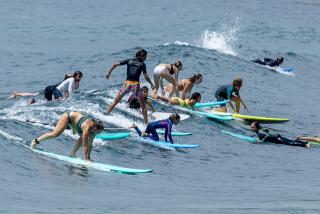Don’t Forget Ps and Qs of Shipboard Etiquette
- Share via
There is a serious matter of cabin etiquette that everyone aboard a small yacht must observe rigorously, or run the risk of never being invited on a cruise again. I’m speaking of boats, say, 34-feet long or less, where cabin space is at a minimum. Everything below must have its proper place and be in that place when not in use to avoid almost instant chaos.
This, of course, is related to the quality of the human condition. Those who leave their personal belongings strewn about do not make desirable cabin mates. It can also become a dangerous matter when a towline, a crank handle for the roller reefing or a fog horn cannot be located in a virtual rat’s nest in some locker.
And then there is the important matter of privacy. An eight-foot by 12-foot living space below deck, such as in my 27-foot sloop Herald Bird, with nearly all the necessary amenities of a home ashore, is hardly a haven of privacy.
Dressing and undressing in mixed company in such small quarters requires that others aboard pretend that the person changing clothes doesn’t exist. Never, under any circumstances, look directly at the person changing. And there is the head. I was amused by David Kasanof’s comments in Wooden Boat magazine about privacy in the head. After all, he says, the head is not really located out in the middle of the main cabin on his boat. (Or on mine.) It only seems that way, especially when there are guests for dinner.
On my boat, the head is located in the forepeak. A door is hinged in such a way that it serves alternately as a locker or closet door and as a door that shuts off the head from the main cabin. There is a certain knack involved in entering the head area and swinging the door closed. The trick is to avoid become wedged hopelessly between the head and the leading edge of the door as you close it.
Once that head door is closed, etiquette demands that the person in there ceases to exist.
Kasanof points out that “it is an especially serious gaffe to include such a person in the main-cabin discussion by asking him any direct questions.”
He concludes that the ability to switch people on and off is where real privacy resides. Without it, a small boat’s cabin would become a zoo.
There is also another bit of yachting etiquette that must be learned by the cook. It is the ability to stumble over other people’s feet without spilling the stew or giving offense. The epitome of artistic etiquette, however, is achieved by the cook who avoids dumping the stew in somebody’s lap when another boat races close by, creating a wake of tidal wave proportions. A cook like that must be complimented on his gymnastic ability, as well as high respect for the feelings of his mates.
And now before leaving the subject of shipboard etiquette, I must mention “while you’re below” courtesy. It’s accepted etiquette for the person who goes into the cabin to comply with requests from those still on deck. For instance:
“While you’re below will you bring up the suntan lotion? . . . Will you hand up my sweater? . . . How about a cold beer? . . . The binoculars are on the port shelf; will you get them for me?”
The requests can seem endless if you happen to be the unfortunate one to go below on a cruise. But take heart, you may be on deck the next time somebody else goes below.
Sailing Notes
Boating accidents in California increased almost 20% last year, while deaths from boating accidents decreased slightly. The State Dept. of Boating and Waterways reports a total of 791 recreational boating accidents, 337 injuries and 93 deaths. The most common causes of deaths were hazardous water, improper weight distribution or overloading, faulty equipment and operator inattention and carelessness.
Alamitos Bay Yacht Club will host Yachting magazine’s One-of-Kind Regatta on Aug. 9-11. The race is designed to determine which are the fastest sailboats of the day. Only one design, day racing boats that have no accommodations, have been invited.
The Seal Beach to Dana Point Race will be held July 27. The event typically draws from 80 to 100 entries. The event is co-sponsored by the Dana Point Yacht Club and the Seal Beach Yacht Club. This will mark the 16th year of the race, usually sailed under a spinnaker run over the 28-mile course.
Buster Hammond, boat-building executive associated with four major Southern California sailboat manufacturers during the last 25 years, has been elected president of the 800-member Southern California Marine Assn. Bruce Brown of Newcomb and Brown, Santa Ana, was elected vice president.
Headquartered in Orange, the association produces three major boat shows in California: the American Boating Jubilee, Long Beach Shoreline Village Marina, July 26-Aug. 4; the 17th annual Southern California International Sailboat Show, Long Beach Convention Center, Oct. 26-Nov. 3, and the 30th annual Southern California Boat Show, Los Angeles Convention Center, Jan. 31-Feb 9, 1986.
More to Read
Sign up for The Wild
We’ll help you find the best places to hike, bike and run, as well as the perfect silent spots for meditation and yoga.
You may occasionally receive promotional content from the Los Angeles Times.






